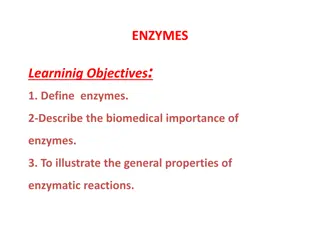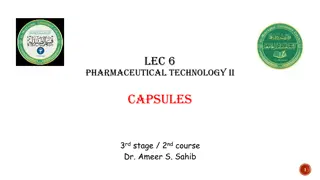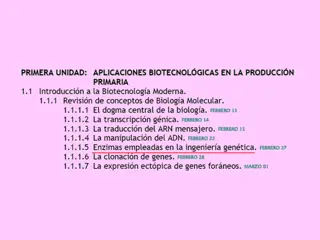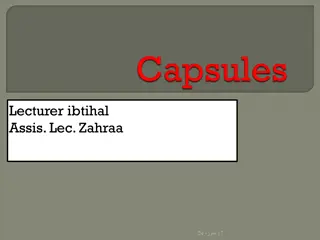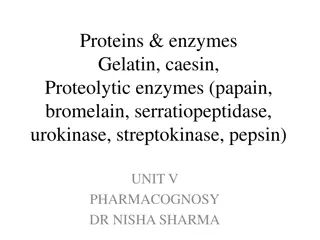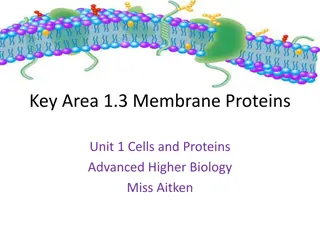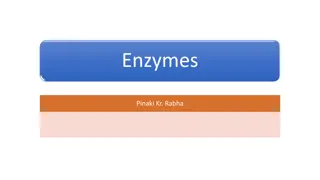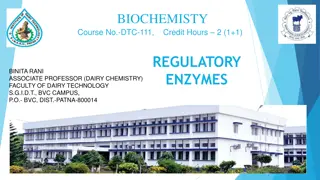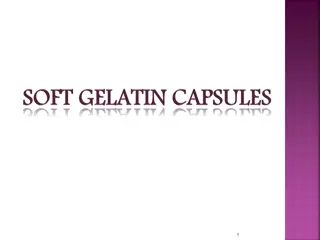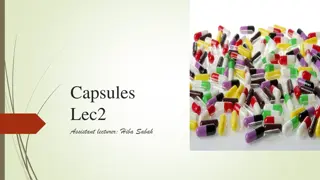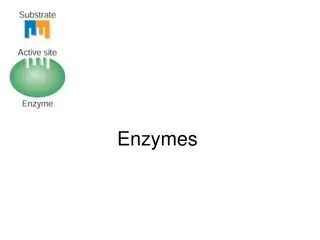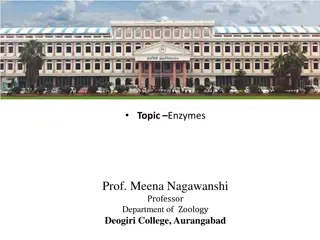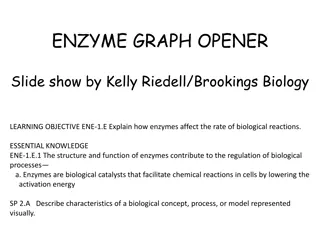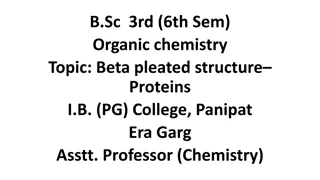Proteins, Enzymes, and Gelatin: A Comprehensive Overview
Proteins are essential for the structure and function of living cells, while enzymes play crucial roles in various biological processes. Gelatin, derived from bones, skins, and tendons of animals, is a valuable substance with unique properties. This content explores the significance of proteins, the diverse types of enzymes, and the extraction process and properties of gelatin.
Download Presentation

Please find below an Image/Link to download the presentation.
The content on the website is provided AS IS for your information and personal use only. It may not be sold, licensed, or shared on other websites without obtaining consent from the author. Download presentation by click this link. If you encounter any issues during the download, it is possible that the publisher has removed the file from their server.
E N D
Presentation Transcript
Proteins & enzymes Gelatin, caesin, Proteolytic enzymes (papain, bromelain, serratiopeptidase, urokinase, streptokinase, pepsin) UNIT V PHARMACOGNOSY DR NISHA SHARMA
PROTEIN It is a complex, high mol. Wt. Organic compound, consists of amino acids joined by peptide bonds. Word protein derived greek: protos = of primary importance . Essential for structure and function of all living cells, for growth and repair Are enzymes or subunits of enzymes. Large molecules, having molecular masses of up to 3,000,000 (the muscle protein titin has a single amino-acid chain 27,000 subunits long). Long chains of amino acids are called proteins, shorter chain lengths are polypeptides , peptides , or rarely, oligopeptides 8 essential amino acids required by humans are: leucine, isoleucine, valine, threonine, methionine, phenylalanine, tryptophan, and lysine.
GELATIN: Syn: Gelatina, Gel foam, puragel B.S. : Obtained by evaporating an aqueous extract made from bones, skins, and tendons of various domestic animals. Some important sources are: Ox, Bos taurus, and Sheep, Ovis aries belonging to family Bovidae Preparation: 1. Raw material: Bones, skins, and tendons of Bovideans 2. Liming Process: skins and tendons are steeped for 15-20 or for 40 days in a dilute milk of lime. Fleshy matter dissolves, chondroproteins of connective tissues gets removed & fatty matter is saponified, then skin is thoroughly washed in running water. 3. Defattying bones is properly ground and defatted in close iron cylinders by treatment with organic solvents such as benzene. The mineral and inorganic part of the bone is removed by treatment with HCl
GELATIN: Syn: Gelatina, Gel foam, puragel 4. Extraction: Treated material from bones, skins and tendons is boiled with water in open pans with perforated false bottom. The clear liquid runs of again and again and is evaporated until it reaches to above 45 per cent gelatin content. 5. Setting: The conc. gelatin extract transferred to shallow metal trays/ trays with glass bottom. Allowed to set as a semisolid jelly. 6. Drying: The jelly, transferred to trays with a perforated wire netting bottom and passed through series of drying compartments of 30 60 C increasing each time with 10 C. For complete drying, it takes about month. Bleaching: If dark colour, finished product is subjected to bleaching by sulphur dioxide. Bleaching affords a light coloured gelatin.
GELATIN: Syn: Gelatina, Gel foam, puragel DESCRIPTION: colorless/slightly yellow, transparent, brittle, practically odorless, tasteless sheet, flakes or Course granular powder. In water it swells and absorbs 5 10 times its weight of water to form a gel in solutions below 35 40 C. It is insoluble in cold water and organic solvents, soluble in hot water, glycerol, acetic acid; and is amphoteric. Gelatinizing property of Gelatin is reduced by boiling for long time. quality of gelatin: jelly strength (Bloom strength) Bloom gelometer two types of gelatin, A and B: A has an isoelectric point between pH 7 and 9. incompatible with anionic compounds such as Acacia, Agar and Tragacanth. Type B has an isoelectric point between 4.7 and 5, and it is used with anionic mixtures
GELATIN: Syn: Gelatina, Gel foam, puragel Chemical Constituents Consist of protein glutin which on hydrolysis gives a mixture of amino acids. Approximate amino-acid are: glycine (25.5%), alanine (8.7%), valine (2.5%), leucine (3.2%), isoleucine (1.4%), cystine & cysteine (0.1%), methionine (1.0%), tyrosine (0.5%), aspartic acid (6.6%), glutamic acid (11.4%), arginine (8.1%), lysine (4.1%), and histidine (0.8%). gelatinizing nature is due to chondrin & adhesive nature due to glutin. USES: to prepare pastilles, pastes, suppositories, capsules, pill-coatings, gelatin sponge; as suspending agent, tablet binder, coating agent, as stabilizer, thickener and texturizer in food; for manufacturing rubber substitutes, adhesives, cements, lithographic and printing inks, plastic compounds, artificial silk, photographic plates and films, light filters for mercury lamps, clarifying agent, sizing paper and textiles, for inhibiting crystallization in bacteriology, for preparing cultures and as a nutrient.
GELATIN: Syn: Gelatina, Gel foam, puragel Chemical Test Biuret reaction : 2ml alkaline solution of a protein+ dil. Sol. CuSO4 red or violet color (if peptides have at least two peptide linkages). Xanthoproteic reaction: Sample + Conc. HNO3+ warm yellow + alkali orange color Millon s reaction: Millon s reagent (mercuric nitrate in HNO3 + trace of HNO2)+ Sample solution white precipitate + Heat Red Ninhydrin test: Aq. Sample sol.+ alcoholic sol. of ninhydrin + heat Red to violet colour 1g Gelatin + soda lime + heat smell of ammonia 0.5g Sample+ 10ml H2O+ 10& tannic acid buff col. Ppt Sample solution + picric acid solution yellow ppt
CASEIN: proteolytic enzyme obtained from the stomachs of calves. It is extracted from the proteins of the milk; in the milk, casein is structured in voluminous globules. It comprises about 80 per cent total protein content of milk. There are two types of casein in the market. Acid Casein: Warm skimmed milk is acidified with dilute acid, the whey is separated, curd is washed several times, dried and pulverised. Rennet Casein: Skimmed milk is treated with an enzyme, rennet extract; product is separated, and purified. Principal casein fractions are alpha (s1) and alpha (s2)-caseins, - casein and -casein. All have low solubility at pH 4.6.
CASEIN: Description: It is white, slightly yellow, tasteless, odourless, amorphous solid, hygroscopic, stable when dry but deteriorates rapidly when damp. Solubility : insoluble in H2O, sol. in dil. alkalies, conc. acids, precipitates from dil. acid solutions. Chemistry of Casein: Casein is a phosphoprotein, contain about 0.85% P & 0.75% S. Contains about 15 amino acids also rich in essential amino acids. Molecular weight 75000 - 3,70,000, Isoelectric point 4.7, Nitrogen content 15 16%. Standards of Quality: Loss on drying: Not more than 6.0 % Sulphated ash: Not more than 1.5% Specific gravity: 1.25 - 1.31.
CASEIN: Chemical Constituents Milk consists of 80% of milk proteins (casein). The major constituents of casein are alpha (s1) and alpha (s2)-caseins, - casein and kappa-casein. These caseins are conjugated proteins with phosphate group(s) which are esterified into serine residues they have a low solubility at pH 4.6. Uses: Useful dietary supplement source of protein in pre and post operative care; as a base in standardisation of proteolytic enzymes and as emulsifying agent. Industrially, used in sizing of textile and paper, as an adhesive, in preparation of casein plastic and casein paints. used by bodybuilders as a slow- digesting source of amino acids



